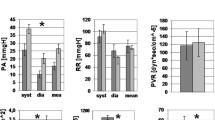Summary.
Background:
In patients with atrial septal defects of the secundum-type (ASD), exercise tolerance is reduced. Generally, ASD closure is recommended in symptomatic patients and in patients with a relevant left-toright shunt (Qp/Qs > 1.5). Only few data are available concerning objective parameters of cardiopulmonary exercise capacity. The aim of this study was to evaluate exercise capacity as achieved by ergospirometry in adult patients with an ASD at baseline and in the long-term following transcatheter closure.
Methods and results:
Thirty consecutive patients (8 male; mean age 43.4 years; defect size 23.5 mm; pulmonary-tosystemic flow ratio (Qp/Qs) 1.94) performed exercise testing on a supine bicycle ergometer. At baseline, oxygen consumption at maximal exercise (VO2 peak) was 14.3 ml/min kg, oxygen consumption at the anaerobic threshold (VO2-AT) was 11.2 ml/min/kg and maximal achieved workload was 86 Watt. At one and six months after ASD-closure, there was no relevant increase of the VO2 peak, the VO2-AT or the maximal workload. After 12 months, there was a significant increase of the VO2 peak (15.1 ml/min/kg, p = 0.049), the VO2-AT (13 ml/min/kg, p < 0.001) and the maximal workload (99 Watt, p < 0.01). An increase of the oxygen consumption at the anaerobic threshold (ΔVO2 AT) could be seen in 24 out of 30 patients and was independent of shunt volume (Qp/Qs ≤ 2, 1.95 ml/ min/kg; Qp/Qs > 2, 2.13 ml/min/ kg; ns), defect size (defect ≤ 24 mm, 2.0 ml/min/kg; defect > 24 mm, 1.5 ml/min/kg; ns), age (age ≤ 44 years, 1.97 ml/min/kg; age >44 years, 1.66 ml/min/kg; ns), gender (female 1.56 ml/min/ kg; male 1.91 ml/min/kg; ns) and of the existence of a residual shunt. Highly symptomatic patients had a tendency to have greater benefit from ASD-closure as compared to mildly symptomatic patients (NYHA 0/I 1.85 ml/min/kg; NYHA II 1.5 ml/min/ kg; NYHA III 2.7 ml/min/kg; ns). There was no correlation between shunt volume, shunt size, pulmonal arterial pressure and increase of the oxygen consumption at the anaerobic threshold (ΔVO2 AT).
Conclusion:
There is no relevant improvement in exercise capacity early (1–6 months) after interventional ASD-closure, but late after ASD-closure (12 months) exercise capacity improves significantly. This improvement can be found in almost all patients independent of gender, age, symptoms, shunt volume and defect size.
Zusammenfassung.
Hintergrund:
Bei Patienten mit einem Vorhofseptumdefekt (ASD) vom Sekundumtyp besteht häufig eine Einschränkung der Belastbarkeit. Bei symptomatischen Patienten und bei Patienten mit bedeutsamen Links-rechts-Shunt (Qp/Qs>1,5) ist daher die Indikation zum interventionellen oder operativen Verschluss gegeben. Objektivierbare Daten der kardiopulmonalen Leistungsfähigkeit im Langzeitverlauf nach ASD-Verschluss liegen jedoch nur in unsystematischem Umfang vor. Ziel unserer Studie war es, die Sauerstoffaufnahme bei Belastung und die maximale Belastbarkeit nach interventionellem ASD-Verschluss im Langzeitverlauf über 12 Monate durch serielle Ergospirometrie zu evaluieren.
Methoden und Ergebnisse:
Bei 30 konsekutiven Patienten (8 Männer, mittleres Alter 43,4 Jahre, Defektgröße 23,5 mm, Qp/Qs 1,94) wurde eine Ergospirometrie mit Belastung am Fahrradergometer im Liegen vor interventionellem ASD-Verschluss, sowie einen, sechs und zwölf Monate danach durchgeführt. Gemessen wurde die Sauerstoffaufnahme bei maximaler Belastung (VO2 peak), die Sauerstoffaufnahme an der anaeroben Schwelle (VO2 AT) und die maximale Belastbarkeit.
Im Vergleich zu den Ausgangswerten vor ASD-Verschluss zeigte sich bei den Nachuntersuchungen einen und sechs Monate nach Verschluss keine relevante Zunahme der maximalen Belastbarkeit, der Sauerstoffaufnahme bei maximaler Belastung (VO2 peak) und der Sauerstoffaufnahme an der anaeroben Schwelle (VO2 AT). Erst nach 12 Monaten kam es zu einer signifikanten Verbesserung aller drei Parameter. Eine Zunahme der Sauerstoffaufnahme an der anaeroben Schwelle (ΔVO2 AT) nach 12 Monaten war bei 24 von 30 Patienten zu sehen und war unabhängig von Shuntgröße, Alter, Geschlecht und vom Vorliegen eines Residualshunts. Hochsymptomatische Patienten profitierten tendenziell von einem ASD-Verschluss mehr als Patienten mit geringer Symptomatik. Es bestand keine Korrelation der Shuntgröße, der Defektgröße und des pulmonmalarteriellen Druckes zur Zunahme der Sauerstoffaufnahme an der anaeroben Schwelle (ΔVO2 AT).
Folgerung:
Nach interventionellem ASD-Verschluss kommt es zu einer kontinuierlichen Zunahme der kardiopulmonalen Leistungsfähigkeit im Verlauf von 12 Monaten. Eine Verbesserung der kardiopulmonalen Leistungsfähigkeit ist bei nahezu allen Patienten unabhängig von Geschlecht, Alter, klinischer Symptomatik, Shuntgröße und Defektgröße festzustellen.
Similar content being viewed by others
Author information
Authors and Affiliations
Corresponding author
Rights and permissions
About this article
Cite this article
Weber, M., Neumann, T., Rau, M. et al. Verbesserung der kardiopulmonalen Belastbarkeit nach interventionellem ASD-Verschluss. Z Kardiol 93, 209–215 (2004). https://doi.org/10.1007/s00392-004-0042-z
Received:
Accepted:
Issue Date:
DOI: https://doi.org/10.1007/s00392-004-0042-z




